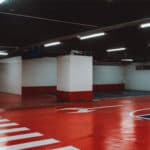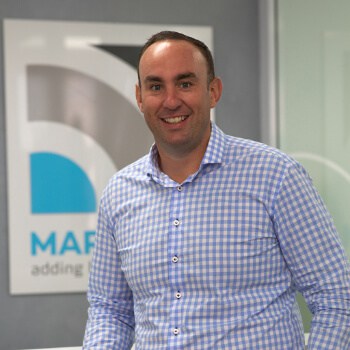From the comfort and inconvenience of their home offices, Christine and Hayden open up the MARKHAM history books to look at where our basement waterproofing experience began. As well as the very first MARKHAM basement project, we hear about some more recent examples and the benefits to the key stakeholders.
MARKHAM’s history of basement waterproofing

Invisible Strength
MARKHAM's history of basement waterproofing
/
RSS Feed
MARKHAM’s history of basement waterproofing
MARKHAM waterproofing: markhamglobal.com/solutions/concrete-waterproofing-system
BASE-TECT: markhamglobal.com/markham-products/complete-systems/base-tect
Case Study – Preston, Vic: markhamglobal.com/markham-videos/case-study-clinch-ave-preston
View the Transcript
CHRISTINE: Kia Ora, everyone, welcome to the latest podcast episode from MARKHAM’s Invisible Strength series. We going to go back in time today; we’re talking about our history and basement waterproofing… and obviously, I haven’t introduced myself!
My name is Christine, I’m from Hawke’s Bay head office. I work in the New Zealand Design and Delivery team; I work mainly with architects as a specification consultant. And with me to talk about MARKHAM basement history is Hayden! Hayden, do you want to introduce yourself?
HAYDEN: Hey, hey, cheers Christine! What a fantastic day, so I’m just looking at my window from a lockdown bedroom. But yes, keen to be on this one. I’m Hayden Prestidge, also based in Napier, but work across New Zealand and Australia. Obviously, that’s a little bit tricky at the moment with everything going on, but I’m thankful for technology in that space.
So our Design and Delivery team is our space and that’s everything projects, so very project-orientated and yes, happy to be on this one. Happy to talk about our history, it’s great. It’s good to see where we’ve actually climbed from, so to speak, and being able to offer what we’ve learned in the industry. So – good to be able to share that today, Christine.
CHRISTINE: Yes, epic! I love a bit of a back story! So as our audience might be familiar, there’s recently, very recently with parcelled our three-part basement waterproofing system into one easily-specified bundle and given it a new name. So that’s BASE-TECT. Do you want to tell us more about that, just briefly?
HAYDEN: Yes, hugely excited about that it! We’ve always had it coming. We’ve always offered waterproofing systems to the industry. But to wrap it up into one, one product, one name, one system – BASE-TECT – its BASEment proTECTion. And yes, that’s all about making it easier to specify, easier to use, easy to detail. And as you say, bundle it together instead of our historical approach, so to speak.
CHRISTINE: Yes, cool, so yes, we’ll head back into the history books and have a talk about how we got here … take us through some example projects as we get along. And yes, how did we get here? What was our first basement waterproofing project?
HAYDEN: Shucks, you’re putting me on the spot here! I guess…
Let’s just jump back a little bit and talk about our products being able to … the deep penetration or the ability of our concrete products to get inside the concrete, especially the spray-applied AQURON 2000. Now we got existing walls, existing slabs, etc. Being able to treat them from the negative side – I’m thinking of like in a basement now – and being able to penetrate into that concrete and seal that porosity has really taught us about waterproofing. So, you know, really stopping moisture migration through the concrete is a big part of it or THE waterproofing.
And with that in mind, I think it was around 1996, or well, it was. I thought it was pre-2000s, our founder Graham Smith used this technology and was able to treat a failed tanking project.
So there’s a project down in Christchurch. It’s close to the Avon River. There was some sort of, I don’t know what happened, but something happened during construction and, whether it was a tear in the membrane or wasn’t completed properly… and moisture was able to get into the concrete.
Using the technology of the spray treatment, and being able to treat the concrete from the inside, getting that penetration; and it basically blocked that moisture coming in. There was a little bit of crack injection and things we had to do, but in essence that spray treatment took it out. That basement is still in use today. I believe it’s at the University. It’s lined and, as a classroom, so obviously it couldn’t be a classroom if you had your bags and your feet in the water or … So, yes, that’s really a good case study for us. I guess. Does that make sense?
CHRISTINE: Yes, that would have been a bit of a light bulb moment. So what did that mean for us after that?
HAYDEN: So for MARKHAM that really meant… and we could have chased that line of work, you know, set up as a, grab a truck and a couple of guys and set up as a concrete remedial, or waterproofing remedial business. And in all aspects, there’s a lot of that work to do. But Graham really stood back and looked at the bigger picture, and thought about our hydrogel treatments there – our admixtures, our spray treatments – and thought, hang on, if we can treat an existing structure, why not use this technology to get it right at the start, and save these problems?
So really from there, the basement waterproofing system was born – so way back at that point.
And being able to provide an admixture into the concrete; obviously a spray-applied treatment as a cure and seal; and then the swellstops, or the waterstops to do all your joints. So it was a bit of a, as you say, a big light bulb moment, but also a bit of a game-changer in the industry at that point.
CHRISTINE: Yes, epic! Knowing Graham, our founder, now he’s in his 80s, but he’s pretty sharp and very innovative – super impressive big picture thinking! And so yes, by using this system we can replace membranes entirely?
HAYDEN: Yes, replace, or not even… I mean they don’t need to come into the thinking pattern now when designers are talking about basement waterproofing. It’s the traditional go-to, Hey I need, I’ve got to waterproof a basement, I need some sort of tanking, I need a membrane over my concrete. That can be taken out of it with this system. So the key to it is to get involved in that design phase, and really make sure we’re talking on the same level, and designing what’s needed for their basement. So whether… what sort of structural system that may be; also the ground conditions, as in the water table etc, contaminated soils, all these sorts of things.
So we can design that. And as you say, we can be the sole waterproofing; and have been in numerous jobs across New Zealand, Australia now with fantastic results.
Not only from results in the waterproofing performance but the actual build, buildability results, designing results. You know, it’s saved huge programming time and detailing time, those sort of things; along with that, offering a really, really strong warranty.
Waterproofing warranty is a pretty hot topic, and being able to provide a strong warranty in that has helped too.
CHRISTINE: Yes, cool! Can you tell us if you … take us more into a few other project examples, to sort of illustrate that further?
HAYDEN: Yes, yes. Well, one I quite like to talk about, and whoever’s listening may have heard me talk about this before, but Westfield Newmarket was a really good one. So 2018, I believe, Scentre Group redeveloped all their shopping mall there. So there are two sides to it. Big basements and big basement slabs. Exciting from a few points of view: the amount of time we could save – so their slabs were all cut up into about 5 or 600 square metre pours, because of the depth of things, and because of the layout of the building. And the construction guys actually told me at one point, You guys are saving us about 10 days per pour! So I don’t know how many pours there would have been, but I’m guessing it would be upwards of 40 across both. You know, we’re talking 20,000 square metres of waterproofing. So if you take just that programme advantage and that must build up to millions, along with the costs itself.
Moving into some of the Australian ones – Preston in Victoria; we were … right at the last minute, they found that they couldn’t use a membrane, it just wasn’t working for what they were trying to do. And we – obviously we would have wanted to get in at the design stage, but we were able to jump in and provide a quick system and waterproof the concrete itself and get a good result there.
We’ve done some sort of different ones, like a big diving pool in Palmerston North. So was 12 metres, I believe, into the water table and so – a pool’s interesting, because you’re stopping water coming out, and you’re stopping groundwater coming in. So that was hugely successful as well, and still in use, I believe.
Yes, it just it, it works, and it works in so many different scenarios; whether it be shotcrete and pile, whether it be cast in-situ concrete walls, whether it be like AFS or formwork system, whether it be a precast panel and all these types of things. Post tension slabs. Conventional slabs. Lift pits. All these tough environments we’ve worked with and successfully – getting stumbled on my words there! – successfully managed to waterproof. So along with that anything concrete! So you know, as we go say, carpark levels or podium levels. Rooftop decks. But anyway, I’m getting carried away. We should focus on basements, right?
CHRISTINE: Yes, we’re going to have to save that one for another time! So yes, I’m sure there’s plenty more we could talk about in terms of where we can use the waterproofing system. And is there anything that it can’t do?
HAYDEN: Well, probably yes. It numerous things that can’t do, but obviously for …
CHRISTINE: Again, what sort of basement don’t you want to look at?
HAYDEN: Talking about waterproofing. Yes, yes, no, good point. There are limitations and one of them is block walls. Concrete block. Basically, with a concrete block, it’s so porous; you haven’t got solid filled concrete, and you’ve got all the mortar joints and things like that; so that there has to go … well, the only option really is a membrane.
Obviously, anything where we’ve got solid concrete we can do a solid system and a solid warranty.
Every project is unique, and every project has its specific challenges, so that’s why we like to get involved early. We like to understand what’s trying to be achieved, and how and where. And we are risk-averse. We’ve backed out of situations where we say, Hang on, that’s not for us, and there’s too much going on here, the build is not right for this type of waterproofing. And we just want everyone to be sure that they’re using the right system. As much as you do, we want the long term result, we want that low maintenance just like the clients.
CHRISTINE: Yes, absolutely. It’s kind of exactly what we’re offering, isn’t it? So the reassurance and reliability of a long-term waterproofing system, and we’ll take on the risk. And yes, it’s a fantastic system.
Thanks so much for going through the history. I learned a little bit, even though I’ve been working with MARKHAM for a while now!
And to all of our listeners, if you need more information, if you just want to do a bit of research as well, our contact details and a truck-ton of information is www.markhamglobal.com
Have a fantastic day. Thanks, Hayden again, and don’t miss our next episode.
HAYDEN: Cheers, Christine!
Want to Contribute?
Feedback on our podcasts? Suggestions for future topics? Looking for more information on topics we’ve discussed? Send us a message – we’ll be in touch within a day or two.
More about MARKHAM
MARKHAM are dedicated to providing innovations for concrete and construction. Focusing on concrete waterproofing solutions, penetrating concrete sealers and durability treatments for concrete.
Podcast Categories
Latest Episodes

Doug & Laike Share Their Week – Western Australia, Christchurch, and a Focus on Low Carbon Concrete
Laike and Doug wrap up their week again with a 10-minute chat. They’ve each been

Doug & Henry Share Their Week – R&D, Melbourne Traffic, Basement Waterproofing, And ‘CONQOR Your Health’
It’s Henry’s turn to join Doug in the podcast studio – in person this time!

Doug & Laike Share Their Week – Seychelles, Readymix Plants, And A Bike Ride
Once again Doug and Laike sit down for a 10 minute recap from the week.
invisible strength podcast
The whole MARKHAM team is pleased to present you with our podcast series, INVISIBLE STRENGTH. In this series of interviews, we’ll walk through the science and challenges of concrete durability, what goes wrong in the field – and the advanced methods available to restore and enhance service life to concrete construction.
INVISIBLE STRENGTH reflects a number of factors in concrete construction and durability. When things go wrong, the evidence can become very visible indeed. However, when all is going well, there’s nothing particular to be seen!
MARKHAM’s concrete treatments, too, are invisible once completed – and the result is the long internal, invisible durability of the concrete.
So join us as we explore the unseen world inside concrete – why it matters, and how it can be protected!

